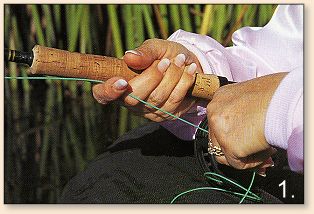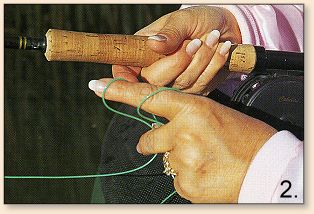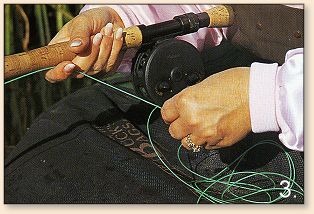Determining Water Depth And Temperature
You can determine the depth and bottom contour
of the lake off shore and the water temperature
at the same time. Kick your tube out about ten feet
from shore to make your first sounding. You can
use an old reel filled with 30 feet of line that
is knoted every ten feet with a thermometer attached
to the end. Lower the thermometer to the bottom
(the line will go slack when it hits the bottom)
and it there for two minutes. Then reel it back
up counting the number of knots in the return to
calculate the depth and read the temperature on
the thermometer. The best water temperature for
trout fishing is 55 - 65 degrees Fahrenheit. You
sjpi;d also check the surface water temperature if you
plan to search the shallows. Then move out to about
30 feet from shore and repeat the procedure. If
your depth soundind is between 5 - 15 feet keep
on the number two sinking line. If the water is
deeper or if you want a fast sink, use the 3 or
4 line. And, if the temperature is within the
trout feeding range, you know that you don't need
to go deeper to find fish as the water is in their
comfort zone. Through this kind of search you
can also find that productive zone where the
shallows drop off into deeper water.
Moving The Fly
In lake fishing, there aren't the same kind of
currents to move the natural insects or your
artificial flies as there are in stream fishing,
so your retrieve (the way you bring in line that
has been cast) and speed of kick are how you impart
natural movement to your artifical fly. Although
this section describes various speeds of retrieve to
attract fish, it is generally thought that most
anglers retrieve too quickly. So, even if you are
impatient to get your line in for another, perhaps
better cast, resist the temptation to go faster.
A slow or super slow retrieve is often best in calm,
clear water while a fast, erratic retrieve may be just
the ticket on a windy, choppy day when trout are chasing
insects stirred up by the wind. It is usually better,
however, to err on the side of retrieving very slowly
than too fast.
Cast and Retrieve
After the cast, let the line sink to the selected
depth and then begin to retrieve the line. The
sinking line will keep the fly at this depth for most
of the retrieve.

To execute the retrieve, point your rod tip down
the line and actually into the water, hold the
rod in your dominant hand, allowing the line to
slip under your index finger for control.
Grasp the fly line between the thumb and forefinger
of your retrieving hand and pull down and back. Then
loosen your grasp on the line, letting it fall onto
the stripping apron and move your hand back up the
line to retrieve again. Line thus retrieved lies in
coils in front of you on the stripping apron ready
for your next cast.

With your rod still angled
toward the bottom of the lake, retrieve your line
until you see the leader. Sometimes fish will
follow your fly right up to the surface before
taking it.
Marvin Taylor (1979) describes several useful retrieves
for lake fly fishing: standard, dead drift, super quick and
hand twist.
- Standard retrieve consists of three inch strips
(or pulls) in grops of three with a three second pause
and repeat. There are three seconds between each strip
(pull -1, 2, 3; pull-, 1, 2,3,; pull-1, 2, 3; pause - 1,
2, 3). You can vary this method by making longer strips
of 8, 15, or 24 inches with the same timing of pulls and
pauses.
- Dead drift is when you let the line sink to the
appropriate depth and troll slowly.
- Super quick is stripping as fast as possible from
bottom to surface using various length strips. This
can be paired with fast kicking at the same time for
even more effect.

- Hand twist is a very slow steady retrieve that is
executed by grasping the fly line between the thumb
and fore finger, pulling a few inches of line toward
the palm, rotating the wrist and recoving even more
line with the other three fingers.
Gary Borger in his excellent video, Stillwater
Fly Fishing, demonstrates a variation of these
retrieves that he calls the strip tease. While
stripping in the slow standard mode, vibrates the rod
by moving the rod tip three inches up and down and
then side to side. This added movement simulated the
often erratic motion of nymphs.
Brian Farrow (1994) adds another retrieve he calls
the twitch-and-stop. After kicking, cast and let
the line drop to the desired depth. Than instead
of stripping just hold the line in your hand and
manipulate it with the forefinger twitching and
then pausing. With this technique your line and fly
are in the water longer and you make less casts.
Gene Trump (1994) offers the turn retrieve. In the
turn retrieve, you cast toward the shore, let your
fly sink to the desired depth, then using your fins
slowly turn your tube in a circular motion while
holding your rod out. The turn allows for a smooth
pulling of the fly that continues as long as you
continue to rotate. This maneuver is particularly
helpful in confined areas where trolling is not
possible.
Another effective retrieve when fishing the bottom or
into weed beds, is to lift the rod tip up to 10 o'clock
position after the fly has settled, then let it drop
back down by lowering your rod tip to the water. Be
sure to recover any slack that may have formed in the
line during this process. Slack in the line can lead
to missed strikes due to the fact that you can't feel
the fish take the fly. This technique can be repeated
during the retrieve and is often very effective because
it simulates the struggle of nymphs making their way
toward the surface while still seeking the security of
their previous home base. ~ PCP
More Strategies next time.
Credits: Excerpt from Float Tube
Magic By Patricia C. Potheir, published
by Frank Amato Publications. We appreciate use
permission.
|




